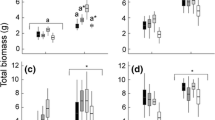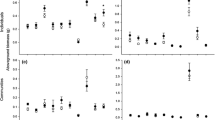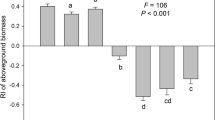Abstract
We analyzed the dynamics of dominant plant species in a grazed grassland over 17 years, and investigated whether local shifts in these dominant species, leading to vegetation mosaics, could be attributed to interactions between plants and soil-borne pathogens. We found that Festuca rubra and Carex arenaria locally alternated in abundance, with different sites close together behaving out of phase, resulting in a shifting mosaic. The net effect of killing all soil biota on the growth of these two species was investigated in a greenhouse experiment using gamma radiation, controlling for possible effects of sterilization on soil chemistry. Both plant species showed a strong net positive response to soil sterilization, indicating that pathogens (e.g., nematodes, pathogenic fungi) outweighed the effect of mutualists (e.g., mycorrhizae). This positive growth response towards soil sterilization appeared not be due to effects of sterilization on soil chemistry. Growth of Carex was strongly reduced by soil-borne pathogens (86% reduction relative to its growth on sterilized soil) on soil from a site where this species decreased during the last decade (and Festuca increased), while it was reduced much less (50%) on soil from a nearby site where it increased in abundance during the last decade. Similarly, Festuca was reduced more (67%) on soil from the site where it decreased (and Carex increased) than on soil from the site where it increased (55%, the site where Carex decreased). Plant-feeding nematodes showed high small-scale variation in densities, and we related this variation to the observed growth reductions in both plant species. Carex growth on unsterilized soil was significantly more reduced at higher densities of plant-feeding nematodes, while the growth reduction in Festuca was independent of plant-feeding nematode densities. At high plant-feeding nematode densities, growth of Carex was reduced more than Festuca, while at low nematode densities the opposite was found. Each plant species thus seems to be affected by different (groups of) soil-borne pathogens. The resulting interaction web of plants and soil-borne pathogens is discussed. We hypothesize that soil disturbances by digging ants and rabbits may explain the small-scale variation in nematode densities, by locally providing “fresh” sand. We conclude that soil-borne pathogens may contribute to plant diversity and spatial mosaics of plants in grasslands.
Similar content being viewed by others
Author information
Authors and Affiliations
Additional information
Received: 19 January 2000 / Accepted: 11 April 2000
Rights and permissions
About this article
Cite this article
Olff, H., Hoorens, B., de Goede, R. et al. Small-scale shifting mosaics of two dominant grassland species: the possible role of soil-borne pathogens. Oecologia 125, 45–54 (2000). https://doi.org/10.1007/PL00008890
Published:
Issue Date:
DOI: https://doi.org/10.1007/PL00008890




